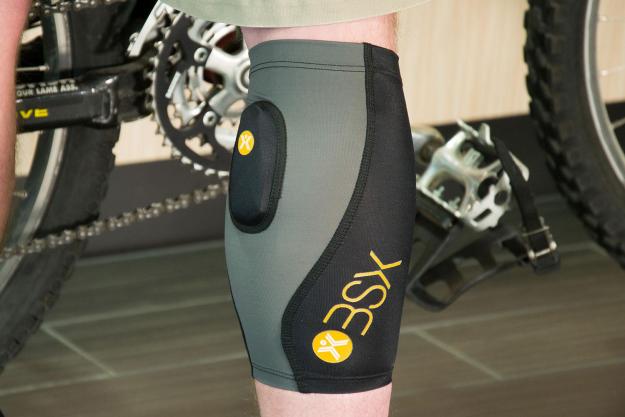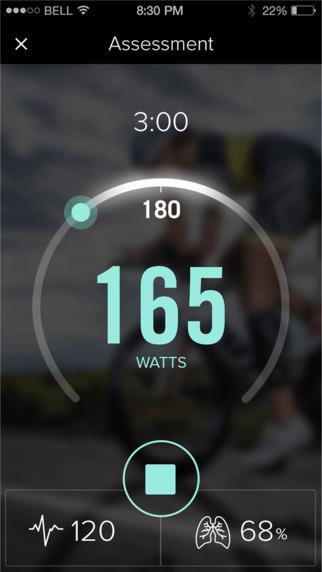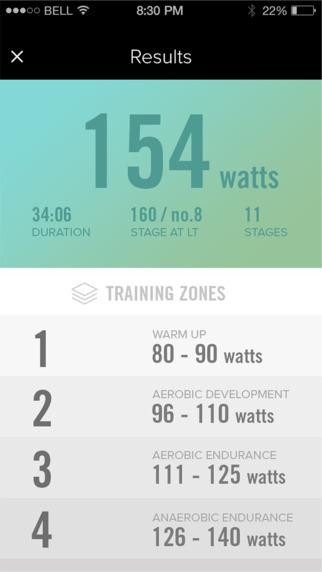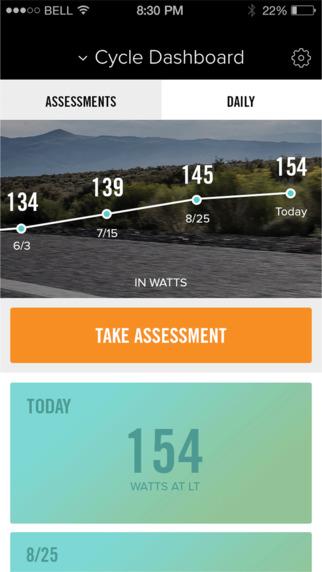
“The BSXinsight is easy to use and delivered a lactate threshold, but it has a ways to go before it makes sense for most athletes.”
- Easy to set up
- No more finger pricks to draw blood
- Small, sleek design
- Only works indoors on treadmill or costly bike trainer
- No audible cues during assessment
- Provides no assessment data
BSXinsight bills itself as “the world’s first wearable lactate threshold sensor. Ever.” Most people would respond, “What?”
Understanding exactly what that means and why it is such a cool technology means knowing at least a little about what lactate is, and how the threshold factors into measuring an athlete’s fitness and proper training.
Here’s a simplified version: When the body works its muscles, they burn energy and produce acid. This acid, lactate, helps a muscle continue to turn energy into power, but when the acid produced outpaces the body’s ability to process or remove it, the muscle begin to feel like it’s on fire. Soon the athlete can stand it no longer and is forced to slow down. That point is the “lactic threshold.” The concept behind “zone training” is that by repeatedly breaking through the LT for short periods of time athletes can raise their threshold higher, allowing their body to go faster, harder, longer.
Before performing zone training, however, athletes must first know where their threshold is so their training zones can be properly set. While many people use heart rate or power meters to measure this, most experts agree that the most precise way to measure fitness is by measuring lactate in the blood during exercise. Blood doesn’t lie.
In the past, getting an accurate lactate threshold measurement meant running on a treadmill or riding a stationary bike at increasing intensities, then having blood drawn (a finger pricked) and tested three or four times. Because of the equipment required, the tests are expensive ($150 to $200) and usually done only by professional athletes with their trainers. BSX Athletics aims to change all that.
Rather than testing blood outside the body, the company uses LED optical sensors to analyze blood inside your body. Not only is this less painful, it also means tests can be performed anytime at home — or in a local gym.
Features and design
The BSXinsight lactate threshold sensor is a simple, black-plastic module with three optical sensor windows on the back. It has no power button nor screen, and looks very much like a heart rate monitor minus the chest strap. In addition to the optical sensors the BSXinsight is armed with both ANT+ and Bluetooth Smart connectivity.
It uses an optical sensor to analyze blood without poking holes in an athlete’s body.
During testing, the lactate threshold sensor is held against the back of an athlete’s calf by a Lycra compression sleeve. It connects via ANT+ either to a heart-rate monitor for a running assessment or both a heart-rate monitor and power meter for bicycle assessment. The sensor then transfers data via Bluetooth Smart to a compatible smartphone running the BSXinsight app (available for iOS and Android).
When the assessment is completed the data is uploaded to BSXinsight’s servers, where it is processed, analyzed, and sent back to the phone as a lactate threshold that can be used to direct future zone-training plans.
What’s in the box
The BSXinsight ships in three configurations. One designed specifically for running, another for cycling, and a third multisport model that can handle both running and cycling. I tested the multisport model; it included the lactate threshold sensor, a Lycra compression sleeve to hold the sensor to the calf, a base charging station, and a microUSB cable for charging and connecting to a computer.
A free downloadable app is available for Bluetooth-equipped iOS and Android phones and tablets, as is a PC or Mac application for use with home computers.
Performance and use
Getting the BSXinsight up and running was not much different from connecting a fitness band to a smartphone. Download the app from the app store and launch it, then create an account, either by entering an email address and password or by using a Facebook or Gmail account. After answering questions regarding gender, our time zone, and favorite measurement standards (U.S. or Metric), along with height, weight, and date of birth, I was ready for an assessment.
In the era of the quantified self, it seems strange that BSX Athletics hides any data from the user.
Doing a proper lactate threshold test requires additional sensors. The cycling test (which would have been my first choice) requires both a heart-rate monitor and a power meter. At $1,500, cycling power meters cost more than many people spend on their bikes. I performed a run assessment instead, which requires simply an ANT+ heart-rate monitor. Here we go — or so I thought.
My first test run was a complete failure. After slipping the Lycra compression sleeve over my right calf and sliding the threshold monitor into the tiny pocket inside it, I was ready to begin. Not having immediate access to a treadmill, I ignored the quick start guide (labeled a “coach’s note”), which said that the “lactate threshold assessments should be completed on a treadmill for best accuracy.” I didn’t need clinical accuracy for this first run, and how big of a difference was it, anyway? Absolutely every one of BSXinsight’s marketing photos (including the one on the front of the box) show the sensor being used outdoors. As I soon discovered, these photos are pure fantasy. More on that later.
After selecting “Take Run Assessment” on the app’s Run Dashboard, I answered a few questions about my current running fitness including conversational pace, current 10k pace, and how long and how much I’ve been training lately. Based on those answers the BSXinsight app created a custom run assessment suited for my fitness level.
The assessment itself breaks down into 10 to 12 three-minute pace levels of increasing speed (a ramp test). Because I was doing the test outside I used a Garmin Fenix 3 GPS watch to stay on the proper pace. The app warned that tests usually last around 30 minutes, but if I logged less than 20 minutes it would have to be repeated. My work was cut out for me.
Most experts agree that the most precise way to measure fitness is by measuring lactate in the blood during exercise.
I started out at a 20-minute mile pace. Every three minutes that app visually reminded me to speed up. There were no audio cues so I couldn’t put headphones on and follow along. I had to run with the phone in one hand so I could see the screen and my watch to make sure I was on pace. At 40 minutes in, with no sign of the app giving me a break, I decided to hit the stop button, hoping for an “assessment complete” notification.
Nothing happened. After a few seconds a screen came up with the following message:
“Lost Connection. Hmmm. . . We lost connection with one or more of your paired devices during the test and are not able to measure your lactate threshold. Please retry the assessment when fully rested, ensuring proper charging and signal of all devices prior to pairing. Questions? Please drop us a line. We’re here to help.”
Few things in athletics are more disappointing that attempting to go your hardest for 45 minutes only to find out that it was all for naught. At no point during the run did the phone lose connection to the heart rate monitor. And it never offered a “lost connection” alert.
Failure. After returning home I sent an email to BSXinsight; I downloaded the PC app and used that to upload the data from my sensor to my account. After viewing it the support technician asked if I’d done the test on a treadmill. I hadn’t. Apparently, a “light leak” caused the lactate threshold sensor to error out — no data could be recovered. The only thing to do was repeat the assessment on a treadmill.
So forget about all those amazing photos of people using the BSXinsight outdoors on the open road surrounded by the beauty of nature. While BSX Athletics hopes to eventually offer outdoor testing, for the time being the product works only indoors on either a treadmill or a trainer. Period. Don’t even try it elsewhere.
In light of the recent treadmill death of Facebook CEO Sheryl Sandberg’s husband David Goldberg, I was none too excited about getting on one, but we’ll do almost anything for a test. So a couple days after that failed run along the beach trail I usually follow, I found myself sneaking into the workout room of a local resort hotel to give the BSXinsight one more chance on a real treadmill.
Placing my phone on the stand below the treadmill monitor made it easy to watch for pace changes. I set the treadmill incline to one percent and bumped the app over to speed so I could control the pace in miles per hour on the treadmill. Again I ran through a set of 10 increasingly intense pace levels. Right after passing the 30-minute mark, the app notified me that the test was over and that my LT had been calculated. Success!
Below the number (hey, that’s personal info) the app displayed my seven training zones and gave a pace or heart-rate range to stay in to training in that zone. For those who zone train religiously, accurate heart rate or pace zones is the most valuable metric gained from lactate threshold testing. But it’s disappointing that I couldn’t look at any of the metrics from the test itself. There was no way to look back at heart rate, blood oxygenation, or even pace over the time of the assessment. In the era of the quantified self, it seems strange that BSX Athletics hides any data from the user. Seeing how your body responded to the increased pace minute by minute is half the reason to have the technology in the first place.
Conclusion
In the fitness technology arms race, a wearable lactate threshold sensor connected to a smartphone could be one of the more important weapons in an athlete’s arsenal. A serious athlete’s arsenal, that is. Those who don’t know their “conversational running pace” or “conversational cycling power” will be stumped by the first question BSX asks during the assessment. And unless an athlete understands zone training and feels they need to better optimize the accuracy of their fitness program, then $414.99 is lot to spend for a device that will only be used eight to ten times a year.
We wish BSX shared the metrics that helped measure the threshold. Doing this would make the entire process more transparent and easier for zone training newbies to understand. It would also be nice if the app had audible cues that counted down to pace changes and alerted users to errors. And then there’s the treadmill problem. It would be amazing if we could have used the BSXinsight in the same way it was featured in the marketing materials: outdoors, in the open air.
The BSXinsight was easy to use and delivered the info it promised, but it has a ways to go before it makes sense for most athletes. Still, for those who have been training their hearts out only to end up in second place, the BSXinsight might be the competitive edge that pushes them to the top step of the podium.
Highs
- Easy to set up
- No more finger pricks to draw blood
- Small, sleek design
Lows
- Only works indoors on treadmill or costly bike trainer
- No audible cues during assessment
- Provides no assessment data
Editors' Recommendations
- YouTuber MKBHD says this new gadget is the worst he’s ever reviewed
- The 10 best photo editing apps for Android and iOS in 2024
- Garmin’s newest wearable is a big upgrade for your sports bra
- WhatsApp finally lets you edit sent messages. Here’s how to do it
- Apple Watch Ultra review roundup: a truly curious beast








